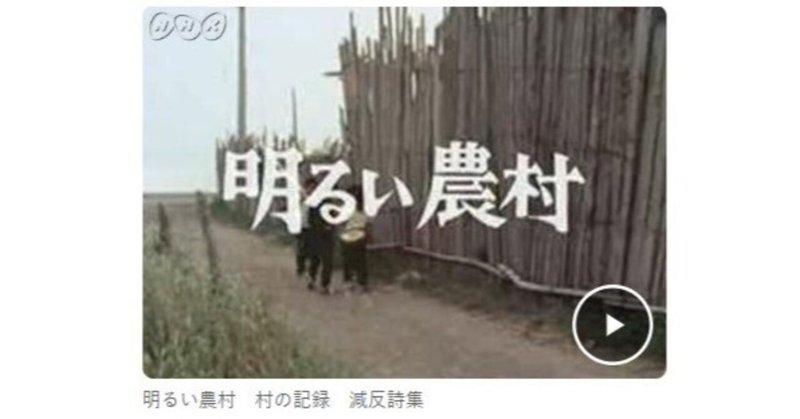
「明るい農村」から「ポツンと一軒家」へ
「ポツンと一軒家」という番組を最近見ている。これは、「衛星写真で見つけたポツンと一軒家を訪問する」という番組である。取材者が、目的地の近くの集落で聞き込みをし、しばしば悪路を乗り越えて、一軒家の主に会うまでが前半である。後半は、一軒家での生活ぶりや来訪者たちを紹介する。
衛星写真を見せながら、地域の人たちに聞いて回るという着想が素晴らしい。他のテレビ局の人たちは、「やられた」と思ったのではないだろうか。
テレビクルーが一軒家にたどりつくまでに話をする人たちの人柄もよく、安心して見ていられる番組である。視聴率が高いのも納得する。

「ポツンと一軒家」のほとんどは、かつて農業や林業を営む集落の中にあったが、今は集落が無くなり、一軒だけ残った状態である。
かつて、NHKで、「明るい農村」という番組を放送していた。この番組で紹介された人たちの世代が、そのような集落で生活していたのだろう。しかし、その人たちはもういない。
残った一軒家の主も、自宅は別にあって、自動車で一軒家に通っているという人が多い。彼らは、家屋や畑を手入れしたり、友人との社交場にしたりしている。
ウィキペディアによると、「明るい農村」という番組は1963年から1985年まで続いた。この番組の内容はほとんど覚えていない。たぶん子どもには面白みのない内容だったのだろう。
朝に「明るい農村」を見ていた頃、農機具メーカーは、テレビコマーシャルを盛んに流していた。
「井関のさなえ」という名前の田植え機を、アイドルスターの一人であった桜田淳子が動かしていたのを覚えている。
農機具メーカーにとっては明るい時代だったのかもしれない。
日経新聞に、このような記事が載った。
この予測が正しいかどうかはわからない。
ただ、私の小学生時代に見た、もう一つのNHKの単発番組を思い出す。
日本の食料事情が壊滅的になるという将来の予想を聞いて、出演した俳優たちが愕然とした表情の演技をする、というドラマだった。
それから50年が経つ。
タイトル写真は、NHKアーカイブスより引用。
From a “lively rural village” to a “detached house with no other houses nearby”
I've been watching a program called "Pottun to Ikkenya" recently. This is a program that visits isolated houses found in satellite photographs. They interview residents of villages near their destination, often crossing rough roads, to meet the owner of a house. The second half of the program introduces the life in the house and the visitors.
The idea of showing satellite photos and asking local people is a great idea. People at other TV stations probably thought they had been defeated.
By the time the TV crew reaches a house, the people they talk to are very friendly, making it a program that you can feel at ease watching. I can understand why the viewership rate is so high.
Most of the "detached houses" used to be located in villages engaged in agriculture or forestry, but now the villages have disappeared and only one house remains.
NHK used to broadcast a program called "Akarui Nouson"(lively rural village). The generation of people introduced in this program probably lived in such a village. But those people are no longer there.
Many of the owners of the remaining houses usually live in other houses and commute to their houses by car. They take care of their houses and fields and use them as places to socialize with friends.
According to Wikipedia, the program ``Bright Village'' ran from 1963 to 1985. I don't remember much of this program. Perhaps the content was not interesting for children.
When I was watching "Akarui Nouson" in the morning, agricultural equipment manufacturers were actively making TV commercials. I remember that one of the idol stars, Junko Sakurada, was operating a rice planting machine called "Iseki no Sanae'"
It may have been a good time for agricultural equipment manufacturers.
An article was published in the Nikkei Shimbun.
I don't know if this prediction is correct.
However, it reminds me of another NHK one-off program that I watched when I was in elementary school. It was a drama in which the actors looked shocked after hearing predictions that Japan's food situation would be catastrophic in the future.
Fifty years have passed since then.
Title photo is taken from NHK archives.
この記事が気に入ったらサポートをしてみませんか?
